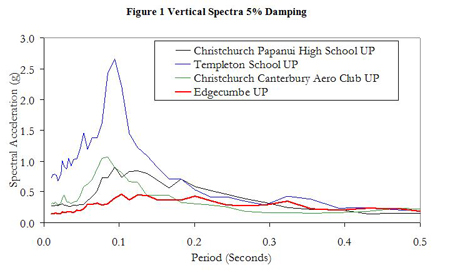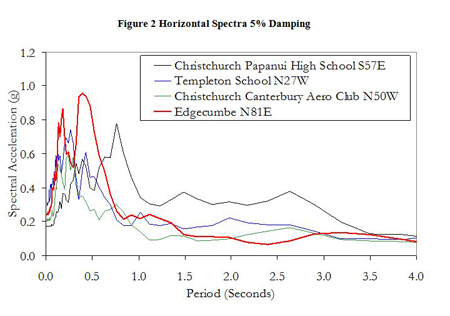The Canterbury earthquake of September 4 has provided an opportunity for the manufacturer of timber water storage tanks in New Zealand, Timbertank Enterprises Ltd., to study the impact this unique event has had on their tanks used in fire systems, town supply and industrial installations.
Timbertanks' managing director Justin Jordan and the company's
consultant engineer Waldo Granwal, met with engineers from Holmes
Consulting Group and Canterbury University College of Engineering,
to discuss the impact on tanks and timber structures of the
earthquake.
There were numerous reports of damage and collapse to water
storage tanks of all makes and while the study will be ongoing,
some initial findings and conclusions were reached. A major
conclusion is that tanks in the Christchurch region will in future
require special design.
"The earthquake was very localised and characterised by the
underlying very deep alluvial shale layer creating an unusual
action of a strong pressure wave followed by a long period of low
frequency secondary shear waves that caused most of the damage in
water tanks," said Waldo. "It was well beyond any previous
expectations specified by the Code at the time for the design and
construction of such tanks. It exceeded it by a large margin -
three to four times more than would have been expected.
"We achieve the code standard as a minimum. If tanks were built
to exceed the standard to withstand such a quake, the cost factor
would outweigh the economic benefit - double the cost. Perfection
is attainable, but it comes at a cost."
Timbertanks inspected a total of 25 tanks that it built over the
last 30 years in the region affected by the earthquake. Of these,
seven tanks lost their water as a result of the 'quake. The
remaining 18 performed as expected - shuffling approximately 20mm
as base isolated tanks are designed to do.
Four out of the seven affected tanks had base isolation
compromised by rigid pipe attachments or illegal ground
obstructions, leaving three tanks that the company "would have
liked to perform better." Certain size diameter tanks only were
affected, others around the epicentre that performed perfectly had
a different diameter.
The locations of all the tanks are shown on the attached map of
the region, showing their proximity to the epicentre and to those
areas where liquefaction affected structures the most. Three were
in the Hornby/Islington area.
It took until a month out from the event to firstly inspect
tanks, then start understanding what had happened and work through
the issues to try and find answers. It evolved with different
inputs being received almost every day. Subsequent after shocks
also exacerbated the situation at a couple of sites.
"Of course we would have preferred the tanks to have performed
better, but with the magnitude of the 'quake being more than anyone
expected and some owners not maintaining the requirement of a base
isolated system... quite frankly at this level we would almost
expect failure," said Justin.
"We were caught out by the extent of the sloshing - the wave
velocity acceleration which caused the tank to move around," he
added. "In all of this, we're learning new things and it takes a
while to understand what happened and then translate into what can
we do better - for us to set up our tanks so they can slide freely
and control the wave slosh.
"Everyone is trying to react quickly to this earthquake but we
also have to ensure we move correctly - because we may have to
change our design as we learn more."
An initial report by AON New Zealand - the Sprinkler
Certification Authority - on tanks inspected after the event, noted
however that the current method of piping Timbertanks via a buried
pipe rising into an anti-vortex plate in the centre of the tank
'appeared sound'. The consequence of the pipe work not being
articulated only caused further damage.
"We agree with the report from AON regarding sprinkler system
performance, of the need to introduce flexibility into piping
design where deflection due to seismic movement is anticipated. In
the Christchurch situation we need to ensure these flexible
knuckles and similar critical features are built in," he said.
The team spent six days collecting information. All the damaged
tanks were fire tanks, all of a similar size over 10-13 metres
across, which appears to equate to the sloshing frequency that
occurred with the water over periods of about three seconds. (Steel
tanks of the same proportions had the same problems).
"We acknowledged that the integrity of fire protection systems
is essential for such as major hospitals, CD headquarters, prisons
or airports. We are working with the Fire Protection industry to
re-establish those tanks as soon as possible, within the required
code."
So is there an answer to this whole earthquake problem, given
that the law requires that a fire tank be designed to retain its
contents and be useable for purpose?
"Anyone who claims that a tank designed to earthquake code
1170.5 would have survived this rogue event does not understand the
whole picture!" says Justin. "Structures susceptible to these large
secondary waves will need special attention beyond code 1170. In
the past, base isolation has neutralised tank slosh - so in
Christchurch a tank with a diameter at risk will have dampening
baffles installed."
"Also in the past we have found it very difficult to go to a
customer and say we believe it's a very good idea that you spend
some money to make your tank earthquake ready. In the 30 years
since it was built, if a tank has not been maintained in a
satisfactory manner to meet the current code, you can expect
problems. And they occurred. This has highlighted the need for more
than normal maintenance to preserve a tank and make it earthquake
ready.
"We will look at better signage around tanks to ensure they are
kept free of debris, earth, structures built up against them etc.,
which would inhibit the base isolation from performing as it
should.
"We will strongly recommend that companies have a maintenance
contract which will provide a warrant of fitness that the tank
meets all the codes for performance in earthquake according to the
existing standards, that they meet the designer's and
manufacturer's specifications for purpose."
Could this happen to other large Timbertanks around the country
- for example large timber Council reservoirs?
"No we don't believe so," said Justin. "We had a tank at
Templeton where the highest reading of the earthquake was taken and
it is working today. The phenomenon that amplified the 'quake in
Christchurch is not to our current knowledge present in any other
location."
As the chaos of Canterbury recedes, a responsible review of
existing clients and their tanks will be a key aspect of
Timbertanks' future work with the Holmes Consulting Group to assure
earthquake readiness of the product. Their design analysis may
evolve to indicate a change to code specifications.
"Any designer is expected to adjust upwardly if present
knowledge has emerged which suggests otherwise - we are obliged to
do just that."
In a recent statement, United States company Caldwell, which has
been building water tanks since 1887 stated: '...only a tank
manufacturer fully understands the structure's design and ongoing
needs that ensure optimal life. Full-service tank manufacturers now
offer extended warranties on new tanks, provided that the tanks are
regularly cleaned, inspected and repaired. Safety improvements and
upgrades are also critical to the tank's long-term usefulness. Life
cycle cost comparisons based on a 40 year time frame fail to
recognise that a well designed tank can be expected to provide
useful service for more than a century.'
Justin adds - "there is a significant cost to upgrade a tank to
meet new conditions and we will be tackling it on two fronts. We
are determined to hold on to our base isolation."
Why did 18 tanks withstand the 'quake? Those that came through
with minimal or no damage related to their locale e.g. they were on
the hillside; they were base isolated and fit for purpose. Large
Timbertanks' water storage tanks in the region at West Moreland and
Springhill, also one in Ashburton, suffered no damage or loss of
function as a result of the earthquake.
Timbertank performance during Darfield 2010 earthquake
- comments from a report by Trevor Kelly - Holmes Consulting
Group
'The Christchurch earthquake motion at the sites where tanks
failed had a combination of high energy content in the long period
range, presumably due to underlying deep alluvium, and high
vertical accelerations in the short period range. The long period
motions cause high surface waves in the tanks which apply large
convective forces to the side of the tank. As these forces are
applied high up the staves, they tend to cause overturning rather
than sliding. This mode of response is undesirable as it permits
the line to extrude beneath the staves where it is damaged.'


'Tank evaluation procedures were developed in the 1990s
partly using observations from the most severe earthquake to which
they had been subjected up to that time - the 1987 Edgecumbe
earthquake. The Christchurch sites at which tank failure occurred
had much greater demands than Edgecumbe in some respects.' -
Holmes Consulting Group
Earthquake Location Map (PDF) showing location of water
tanks which failed and those which survived